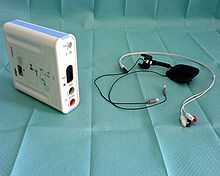In anesthesia, a branch of medicine, Neuromuscular monitoring is a technique used during recovery from the application of general anesthesia to objectively determine how well a patient's muscles are able to function. It involves the application of electrical stimulation to nerves and recording of muscle response using, for example, an acceleromyograph. Neuromuscular monitoring is typically used when neuromuscular-blocking drugs have been part of the general anesthesia and the doctor wishes to avoid postoperative residual curarization (PORC) in the patient, that is, the residual paralysis of muscles stemming from these drugs. Before the patient is fully awake, voluntary muscle testing is not possible and indirect clinical tests, such as apparent muscle tone and pulmonary compliance, can be affected by factors other than PORC. Direct neuromuscular monitoring avoids these problems and allows the doctor to remedy PORC before it becomes a source of patient distress.[1][2][3][4][5]

Nerve stimulator

Nerve stimulator

Modifizied mechanomyography. Electrodes on n. ulnaris
References
- ↑ Viby-Mogensen, Jorgen. "Neuromuscular Monitoring". Retrieved 7 March 2013.
- ↑ Harvey AM, Masland RL: Actions of durarizing preparations in the human. Journal of Pharmacology And Experimental Therapeutics, Vol. 73, Issue 3, 304-311, 1941
- ↑ Botelho SY: Comparison of simultaneously recorded electrical and mechanical activity in myasthenia gravis patients and in partially curarized normal humans. Am J Med. 1955 Nov;19(5):693-6. PMID 13268466
- ↑ Christie TH, Churchill-Davidson HC: The St. Thomas's Hospital nerve stimulator in the diagnosis of prolonged apnoea. Lancet. 1958 Apr 12;1(7024):776. PMID 13526270
- ↑ Engbaek J, Ostergaard D, Viby-Mogensen J: Double burst stimulation (DBS): a new pattern of nerve stimulation to identify residual neuromuscular block. Br J Anaesth. 1989 Mar;62(3):274-8. PMID 2522790
Further reading
|
|---|
| | Types | |
|---|
| | Techniques | |
|---|
| | Scientific Principles | |
|---|
| | Measurements | |
|---|
| | Instruments | |
|---|
| | Drugs | |
|---|
| | Complications | |
|---|
| | Fields of study | |
|---|
| | Professions | |
|---|
| | History | |
|---|
| | Organizations | |
|---|
|


